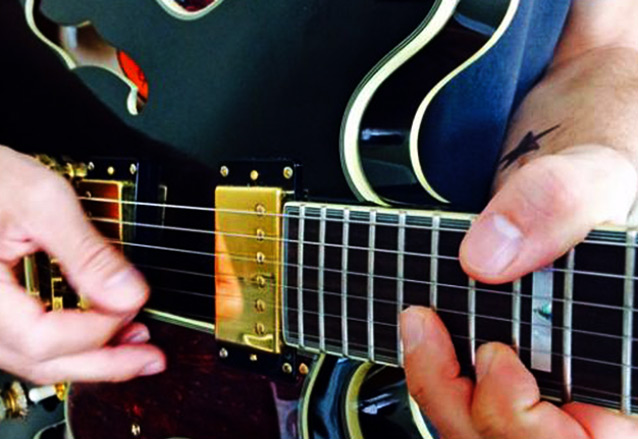Adding Tension to the Minor Jazz-Blues Progression
Learn some cool variations of this progression that feature added chord changes and spicier harmony and voice-leading.

Continuing our exploration of the minor jazz-blues progression I introduced last month, I’d like to now show you some cool variations on it that are sometimes used by jazz musicians and feature added chord changes and spicier harmony and voice-leading.
What I’m going to do here is take the root-third-seventh (or root-seventh-third) “shell voicings” I presented last time and add what are called tension tones on top of them, such as the ninth, 13th or raised fifth.
We’ll also encounter some additional chords that are inserted into the progression, which add interesting root motion and present an improviser with more chord changes to melodically describe when soloing.
FIGURE 1 takes the basic minor jazz-blues changes we looked at last time and adds the ninth to the one chord, Em7, making it Em9 (theoretically spelled, E G B D F#). Notice that we’re leaving out the fifth, B, in the voicing of this chord, which not only lays better on the guitar but also makes for a tighter-sounding voicing. (Remember, sometimes less is more.)
Speaking of tightness, notice that we’re now using a sparse, punctuated comp (accompaniment) rhythm (optimally performed with hybrid picking), with lots of up-beat syncopation, as opposed to the traditional big-band–style “flat four” quarter-note strumming employed last time, which you could alternatively employ here. The B7#5 chords added in bars 1, 2 and 6 create harmonic activity and tension, by momentarily “backpedaling” through the cycle of fourths before resolving to Em9, the one chord.
The C#m7#5 chord in bars 8 and 9 similarly adds root-motion activity and interest and creates a smooth, satisfying transition to C13. E7b9 and #9 (bars 3 and 4) are harmonic extensions of E7, which is the “five chord of the four chord (or “five of four”), and make the “push” and resolution to Am7 that much more compelling and dramatic. By the way, notice the smooth, melodic voice-leading on the B-, G- and D-string notes throughout the entire figure.
FIGURE 2 introduces a “one-six-two-five” change in both the first and last two bars of the progression. The C#m7b5 chord “lives” in the E Dorian mode (E F# G A B C# D), and F#m7b5 is diatonic to E Aeolian (E F# G A B C D). The turnaround featured in bars 11 and 12, while employing the same root motion as bars 1 and 2 (E-C#-F#-B), features two daringly altered, pungent chord qualities, namely C#7#9#5 and F#7#5#9. Em6/9 (bars 10 and 13) is simply an alternative chord choice for Em9, both hailing from the E Dorian mode.
All the latest guitar news, interviews, lessons, reviews, deals and more, direct to your inbox!
For more in-depth analysis of the examples presented in this lesson and some complimentary soloing over them (plus walking bass lines), be sure to check out the video below. Next time, we’ll focus on single-note improvising over the minor jazz-blues progression.

Over the past 30 years, Jimmy Brown has built a reputation as one of the world's finest music educators, through his work as a transcriber and Senior Music Editor for Guitar World magazine and Lessons Editor for its sister publication, Guitar Player. In addition to these roles, Jimmy is also a busy working musician, performing regularly in the greater New York City area. Jimmy earned a Bachelor of Music degree in Jazz Studies and Performance and Music Management from William Paterson University in 1989. He is also an experienced private guitar teacher and an accomplished writer.

